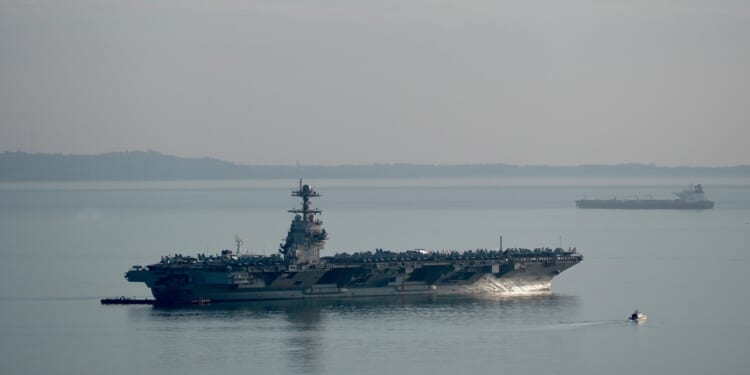In the run-up to the exercises, it was feared that one Russian hypersonic-capable Yasen-class submarine came within firing range of the Ford.
In what is a very serious signal to Moscow from Washington, the USS Gerald R. Ford, the United States Navy’s newest and largest aircraft carrier, is currently leading a strike group (CSG) in NATO’s Neptune Strike 25-3 exercise. This is an enhanced vigilance activity that is taking place in the High North regions of the North Sea, just off Norway’s coast.
The USS Gerald R. Ford’s Specifications
- Year Commissioned: 2017
- Length: 1,106 ft (337 m)
- Beam (Width): 256 ft (78 m)
- Displacement: ~100,000 long tons (112,000 t)
- Engines: Two Bechtel A1B PWR nuclear reactors; four propeller shafts
- Top Speed: ~30 knots (35 mph, 56 km/h)
- Range: Unlimited; approx. 25 years before nuclear refueling
- Armaments: Two RIM-162 ESSM launchers; two RIM-116 RAM launchers; three Phalanx CIWS systems; four Mk 38 25mm machine guns; four .50 caliber machine guns
- Crew: 4,539, including air wing
The “Neptune Strike” Exercises Take Place Every Year
NATO regularly conducts “Neptune Strike” exercises between allied fleets in order to enhance their interoperability in readiness for a major conflict. Two iterations of the exercises have already taken place in Europe this year; the third ran last week from September 23 to September 27.
Notably, this iteration of the exercises involved the Ford operating further north than any US carrier in years—reaching areas near Svalbard and controlling strategic chokepoints, like the “Bear Gap” between the Barents Sea and North Atlantic.
Besides the Ford—with Carrier Airwing Eight on board—the destroyers USS Mahan (DDG-72), USS Winston S. Churchill (DDG-81), and USS Bainbridge (DDG-96) are operating alongside the carrier. The American vessels have been conducting joint operations with allied vessels, such as French frigate FS Bretagne (D655), Danish frigate HDMS Niels Juel (F363), and others from Germany and Norway.
Specific activities included carrier-based F/A-18 fighter jet missions with live weapons drops, combat search-and-rescue drills with the Royal Danish Air Force, helicopter visit-aboard-search-and-seizure training, submarine patrols, surface warfare exercises, and mass casualty simulations—all while integrating into NATO’s command structure for the first time in its deployment. More than 10,000 personnel from 13 NATO nations participated in the exercises, showcasing multinational coordination across air, land, and sea domains.
NATO Is Thinking Hard About the High North
The High North and Arctic regions are increasingly strategic. New shipping routes, like the Northern Sea Route, have opened and are now becoming flashpoints in geopolitics. Vast, untapped resources such as oil, gas, and rare earth minerals are all in abundance in the High North. Predictably, Russia claims much of the Arctic as its own, and for too long the United States and its allies have given Moscow a relatively free hand in the region.
This deployment signifies a serious change in that posture. In the context of the ongoing Ukraine War and worsening relations between Russia and the West, the exercises suggest that Washington is unlikely to simply leave the Russians in peace there.
What’s more, the deployment of the new Ford-class carrier along with a multinational flotilla is seen as a stress test both for the new carrier and the alliance. These exercises showcase how the alliance can operate effectively in extremely cold-weather conditions, secure freedom of navigation through key maritime chokepoints, and deter regional aggression in a contested area.
Predictably, Russia is upset with these movements. The Kremlin has expressed the view that NATO’s northern exercises are a provocative encroachment on its doorstep—threatening its “bastion” defense strategy in the Barents Sea, where Russia protects its nuclear submarine fleet and northern flank. Russian ships and aircraft have been observed surveilling the US-Norwegian joint groups in the High North, indicating heightened monitoring and concern.
The Kremlin has previously described previous US carrier visits to Norway—like the Ford’s recent port call in Oslo—as “illogical and harmful,” arguing these visits escalate tensions unnecessarily in a region Moscow considers part of its sphere of influence.
Recent Russian actions, such as airspace violations over Estonia and overflights of NATO warships in the Baltic have coincided with these exercises, prompting NATO to condemn them as “escalatory” and “reckless.”
The Ford Is Vulnerable to Hypersonic Weapons
Reports of intense anti-submarine warfare operations hunting Yasen-class submarines near the USS Gerald R. Ford further fuel the tensions. In the run-up to the exercises, it was feared that one Russian Yasen-class submarine—capable of deploying hypersonic weapons against which the American carrier has no true defense—came within firing range of the Ford at the start of its journey to the High North.
NATO chased the Russian submarine away. But it shows how serious things have gotten. And with the recent wave of drone incursions into NATO airspace by Russia, and the statement by NATO officials that the alliance will shoot down any Russian warplane that crosses into the airspace, the table is set for a very serious conflict.
Ultimately, despite the Ford’s technological advances, the carrier is largely a sitting duck for Russian hypersonic weapons and submarines. If a shooting war were to erupt between NATO and Russia, that magnificent carrier might be the first victim.
About the Author: Brandon J. Weichert
Brandon J. Weichert is a senior national security editor at The National Interest. Recently, Weichert became the host of The National Security Hour on America Outloud News and iHeartRadio, where he discusses national security policy every Wednesday at 8pm Eastern. He is also a contributor at Popular Mechanics and has consulted regularly with various government institutions and private organizations on geopolitical issues. Weichert’s writings have appeared in multiple publications, including The Washington Times, National Review, The American Spectator, MSN, The Asia Times, and others. His books include Winning Space: How America Remains a Superpower, Biohacked: China’s Race to Control Life, and The Shadow War: Iran’s Quest for Supremacy. His newest book, A Disaster of Our Own Making: How the West Lost Ukraine is available for purchase wherever books are sold. He can be followed via Twitter @WeTheBrandon.
Image: Shutterstock / SimoPitt.


















